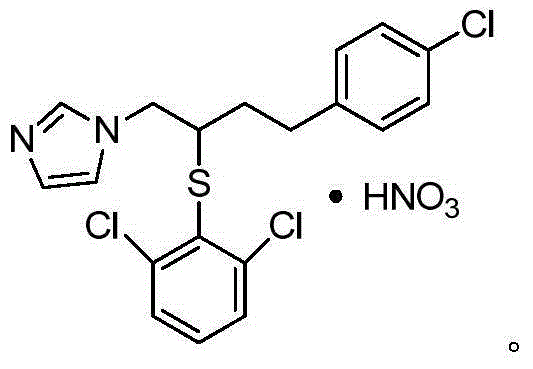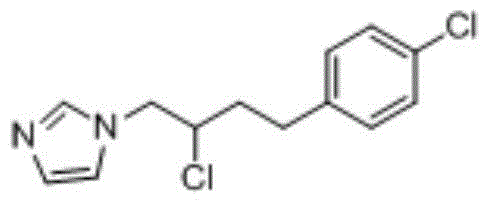Method for industrially producing butoconazole nitrate intermediate
A technology for butoconazole nitrate and intermediates, which is applied in the field of industrial production of butoconazole nitrate intermediates, can solve the problems of high cost, complex production process of butoconazole nitrate, product yield and purity that cannot meet industrial production, etc.
- Summary
- Abstract
- Description
- Claims
- Application Information
AI Technical Summary
Problems solved by technology
Method used
Image
Examples
Embodiment 1
[0053] 1-(2-Chloro-4-(4-chlorophenyl)butyl)-1hydro-imidazole was prepared according to the following procedure:
[0054] (1) 5kg1-(2-hydroxy-4-(4-chlorophenyl)butyl)-1hydro-imidazole, fully dissolved in 35kg dichloromethane, drop 5kg at a rate of 1.5ml / s at 20°C For thionyl chloride, slowly heat up to 32°C, keep the temperature for 1 hour, then reflux at 60°C for 1 hour, and slowly cool to 15°C to obtain the reaction solution;
[0055] (2) Add water at 10°C at a rate of 0.5ml / s to the reaction solution obtained in step (1) while stirring, the volume ratio of the reaction solution to water is 0.005:1, and then add no Sodium carbonate water, filter with suction, discard the solid, concentrate the liquid at 55°C until no dichloromethane evaporates, and dry to obtain the obtained product.
[0056] After testing, the yield of the product in this example was 99.18%. The target product and impurity content were detected by HPLC and standard substances. After testing, the content o...
Embodiment 2
[0058] Compared with Example 1, the difference is only that the step (2) is specifically:
[0059] (2) Add water at 10°C at a rate of 0.1ml / s to the reaction solution obtained in step (1) while stirring, the volume ratio of the reaction solution to water is 0.004:1, and then add no Sodium carbonate water, filter with suction, discard the solid, concentrate the liquid at 50°C until no dichloromethane evaporates, and dry to obtain the obtained product.
[0060] After testing, the yield of the product in this example was 98.78%. The target product and impurity content were detected by HPLC and standard substances. After testing, the content of the target product 1-(2-chloro-4-(4-chlorophenyl)butyl)-1 hydrogen-imidazole is 98.86%, 1-(1-chloro-4-(4-chlorophenyl The content of )butane-2-yl)-1 hydrogen-imidazole was 0.66%, and the content of 1-(2-hydroxy-4-(4-chlorophenyl)butyl)-1 hydrogen-imidazole was 0.21%.
Embodiment 3
[0062] Compared with Example 1, the difference is only that the step (2) is specifically:
[0063] (2) Add water at 20°C at a rate of 1ml / s to the reaction solution obtained in step (1) while stirring, the volume ratio of the reaction solution to water is 0.006:1, and then add anhydrous Sodium carbonate, filter with suction, discard the solid, concentrate the liquid at 60°C until no dichloromethane evaporates, and dry to obtain the obtained product.
[0064] After testing, the yield of the product in this example was 98.65%. The target product and impurity content were detected by HPLC and standard substances. After testing, the content of the target product 1-(2-chloro-4-(4-chlorophenyl)butyl)-1 hydrogen-imidazole is 98.98%, 1-(1-chloro-4-(4-chlorophenyl The content of )butane-2-yl)-1 hydrogen-imidazole was 0.63%, and the content of 1-(2-hydroxy-4-(4-chlorophenyl)butyl)-1 hydrogen-imidazole was 0.23%.
PUM
 Login to View More
Login to View More Abstract
Description
Claims
Application Information
 Login to View More
Login to View More - R&D
- Intellectual Property
- Life Sciences
- Materials
- Tech Scout
- Unparalleled Data Quality
- Higher Quality Content
- 60% Fewer Hallucinations
Browse by: Latest US Patents, China's latest patents, Technical Efficacy Thesaurus, Application Domain, Technology Topic, Popular Technical Reports.
© 2025 PatSnap. All rights reserved.Legal|Privacy policy|Modern Slavery Act Transparency Statement|Sitemap|About US| Contact US: help@patsnap.com



